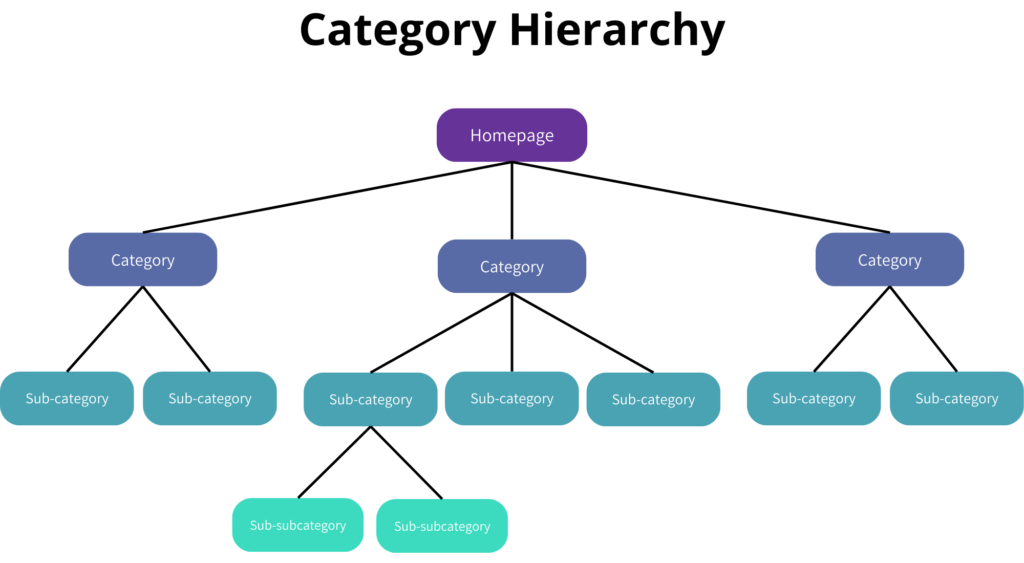Category Hierarchy 101: The Guide to Organising Your Website for Better SEO
3 August 2023 Blog Posts
Getting your category hierarchy (website structure) right can have a significant impact on SEO results. It can enhance rankings, make high-competition keyword rankings achievable, and mitigate the negative impact of Google algorithm updates.
Our approach is based on Google’s product taxonomy. The taxonomy is a representation of how Google assigns products into categories. It is very clear and easy to understand. By following this guideline when we structure your website, we ensure that Google understands the website’s structure. This leads to better rankings and an enhanced user experience.
Let’s dive into the key aspects of website structure and how it can significantly influence your search engine rankings.
The difference between category hierarchy, website structure and website hierarchy
The terms “structure,” “hierarchy,” “category hierarchy,” “levels,” and “folder structure” all refer to the same concept. It involves arranging your website into parent categories, subcategories, and even sub-subcategories. This clear hierarchy allows for easy navigation for both your users and for search engines.
Note: Shopify has no structure, it is all single-level. This is one of the biggest disadvantages of choosing Shopify as your eCommerce platform.

The difference between the website structure and the menu bar
Your website structure can differ from the menu bar, allowing for a more focused and user-friendly navigation experience. Non-clickable categories in the menu bar can also be beneficial.
What makes a successful website structure?
A good category hierarchy and website structure should be product-led, not focused on search volume. For example, if you have 20 paisley notebooks, it may be the best choice to create a category page for this style of notebooks, regardless of search volume. Alternatively, if “floral notebooks” has a high search volume, but you only stock two notebooks that fit this category, we recommend not creating a category page.
We highly recommend keeping the number of first-level categories to a maximum of 10, prioritising the most important categories on this level. Typically, we keep a website to less than four levels. Too many levels can be confusing to the user and not required.
Benefits of a proper category hierarchy
If you get your category hierarchy correct, it can do much of the heavy lifting for your SEO results. The structure must have the correct identity for your website for this to work.
Other benefits of a correct category hierarchy include:
- High-competition keywords being more achievable
- Google algorithm updates having less negative impacts on your rankings, and
- New pages ranking faster.
The role of branded traffic in your website category hierarchy
Branded traffic plays a significant role in driving crawling traffic and passing value from the homepage to each category and subcategory. To optimise your site’s structure, consider not creating subcategories if the parent category isn’t ranking well, as it may not effectively pass down value. However, if the parent category is performing well, creating subcategories can lead to quick wins.
The homepage typically receives the highest branded traffic as it establishes your brand and showcases your product offerings. Category pages, on the other hand, are more product-focused, while product pages cater to specific items.
Branded searches can result from various marketing efforts, including ads, radio, and social media. Using a tagline, like “Hotel Trivago” in advertisements can enhance brand recognition and generate branded searches. Building your brand helps leverage non-branded keywords, further supporting your website’s overall structure.
Rankings can grow from bottom to top, allowing you to compete on higher-level categories as you secure rankings on lower-level ones. Start by creating three levels of categories, prioritising SEO efforts on level two and three categories. Once these simplified levels start ranking well, then move your focus to higher-level categories. The key is to make sure the categories are relevant to each other, as this improves your chances of ranking higher and provides a better return on investment (ROI). This progressive approach helps bolster your site’s visibility and credibility.
When is it best to delete a category?
If you find yourself in a situation where the same products are assigned to multiple categories, it’s essential to take a strategic approach to maintain an organised website structure.
If you find that the same products are assigned to multiple categories, you have several options. First, you can merge categories and keywords to streamline your structure. Second, you could eliminate any duplicate categories to avoid confusion. Alternatively, you might need to assess if the overall structure aligns with your website’s objectives (as it may be incorrect).
On the other hand, if you have insufficient products to fill a category, you have a few different options. One option is to inactive the category until enough relevant products are available. Alternatively, you can keep the category for future expansion when you acquire more suitable products. Finally, you could acquire additional products that would be appropriate for the category.
Summary
In conclusion, a well-organised website structure is the foundation for successful SEO efforts. By following a logical hierarchy, focusing on relevance, and optimising for your specific brand and products, you can greatly improve your search engine rankings and achieve tangible business growth. Remember that your website’s structure must align with your brand identity to maximise its potential.





